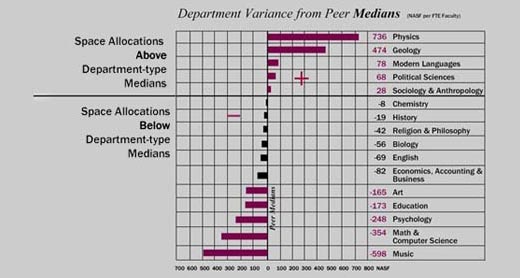|
||||||
This issue examines a subtle but significant principle of campus planning that distinguishes it from campus design. While the two are related and each is required for sound campus development, the distinctions are real. Establishing clarity about the fundamentally different goals, essential concerns, and technical skills involved is important for institutions. We also look at campus and facility benchmarking as tools to create a context for making planning decisions about appropriate levels of space allocation. This technique can reduce the uncertainty in setting targets and allow for informed evaluation of campus plan alternatives.
George Mathey
|
||||||
Campus Design and Campus Planning – Don’t Confuse Them |
|||||||
Difficulties arise when one is confused with the other. Design without comprehensive planning is ad hoc and lacks substance. Often, a college or university seeks a campus plan, but develops a campus design, without understanding the difference, and without understanding or appreciating the complexity of the planning process.
Vocabulary Distinguishes Planning from Design Words and concepts used in the process of campus design include: architectural style, building elements, campus style, design principles, campus characteristics, landscape, lighting, materials, massing, natural site characteristics, outdoor spaces, pedestrian circulation, scale, signage, street furniture, topography, and vehicular circulation. Successful Campus Planning Begins with the Institution's Mission and Vision John Carroll University recently developed one of the best examples of mission and vision incorporated into the planning process. Although used primarily for facility planning, it is a model for campus planning as well. Fundamental to the vision were six themes: curriculum integration, use of technology, student recruitment and retention, student and faculty research, pedagogy and faculty/student relationships, and pre-k-12 science and mathematics education. Each theme had its rationale, set of goals, and implementation strategies for realizing the goals. Some of the strategies had staffing implications, others had campus and facility implications, and still others had programmatic or pedagogical consequences. Successful Campus Design Has a Set of Guiding Assumptions In preparing design guidelines for future campus development, Clemson University identified overarching design principles. These principles fall into three categories –– to promote intellectual and social interaction, to respect cultural and historic resources, and to value sustainable design. From these principles, Clemson developed a set of design guidelines and planning standards that provide the University with a working framework to guide any changes to the campus. The design guidelines are more specific than the principles and provide direction for campus design, landscape, and building projects. Campus planning and campus design –– process and product; both rely on fundamental but different assumptions; both require a related but different approach. Planning is action oriented –– design shapes the action. Don't confuse the two.
Arthur Lidsky |
|||||||
Sensible Benchmarking How Benchmarking Works Comparisons using ratios, however, provide a metric for general assessment. The resource being compared is the numerator of the equation: a definable spatial area, e.g., non-residential space or the area dedicated to a department. The denominator is the number of people to be accommodated — expressed as full-time equivalency (FTE), be it faculty, students, or staff.
Benchmarking may be an assessment at a departmental comparison or campus comparison. Compare institutions by sampling analogous entities, defined by context (urban, rural) or size (similar enrollments and staffing levels). Making a Case for Expansion We assembled data on a sampling of institutions with similar urban settings and Carnegie classifications to create a paradigm profile. The sample's mean and median bracketed our client's FTE enrollment and faculty counts. We were then able to state that our client school operated with less than a quarter of the acreage typically associated with a school of its enrollment and about two-thirds the non-residential space allocated both to FTE faculty and FTE students. Benchmarking made the case for the campus plan to advance proposals for land acquisition and for the construction of significant new academic facilities.
|
||||
| News | ||||||
| DLC+A Presentation at a Three-Day Seminar with Project Kaleidoscope Arthur Lidsky led a discussion on “Principles of Strategic Planning for Leadership Teams” at the PKAL Leadership Initiative Seminar in Atlanta, Georgia. Over 20 colleges and universities participated in the seminar. |
Perspectives Article Appears in Facilities Engineering Journal George Mathey’s “Facility Renewal” article from the September-October issue of Perspectives was selected for inclusion in the November/December issue of AFE Facilities Engineering Journal, a publication of the Association for Facilities Engineering. |
|||||
| DLC+A Will Present at MIT Two-Day Course Arthur Lidsky will present “Campus Programming, Planning, and Design” for MIT's Department of Urban Studies and Planning at a two day workshop on campus planning scheduled for January 13-14. The course is designed to give students and professionals an introduction to how institutions work, how they plan, how they are financed, and how they deal with design and development projects. |
DLC+A To Be Faculty at Integrated Planning Institute Arthur Lidsky will be a faculty member presenting on campus planning for SCUP's Integrated Planning Institute on January 20-24 in Tempe, Arizona. The session will be “Step II: Integrated Application-Integrated Planning and Problem Solving.” |
|||||
| Links Newsletter Archive Related Topics About Us Additional Service |
© Copyright 2004 DOBER LIDSKY MATHEY Creating Campus Solutions |
|||||||
464 Common St., Suite 336
|
||||||||




